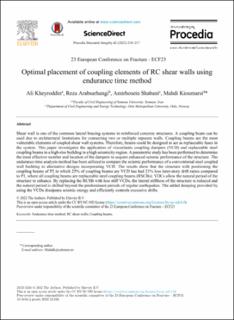| dc.contributor.author | Kheyroddin, Ali | |
| dc.contributor.author | Arabsarhangi, Reza | |
| dc.contributor.author | Shabani, Amirhosein | |
| dc.contributor.author | Kioumarsi, Mahdi | |
| dc.date.accessioned | 2023-03-20T14:51:07Z | |
| dc.date.available | 2023-03-20T14:51:07Z | |
| dc.date.created | 2023-01-03T21:28:31Z | |
| dc.date.issued | 2022 | |
| dc.identifier.citation | Procedia Structural Integrity. 2022, 42 210-217. | en_US |
| dc.identifier.issn | 2452-3216 | |
| dc.identifier.uri | https://hdl.handle.net/11250/3059364 | |
| dc.description.abstract | Shear wall is one of the common lateral bracing systems in reinforced concrete structures. A coupling beam can be used due to architectural limitations for connecting two or multiple separate walls. Coupling beams are the most vulnerable elements of coupled shear wall systems. Therefore, beams could be designed to act as replaceable fuses in the system. This paper investigates the application of viscoelastic coupling dampers (VCD) and replaceable steel coupling beams in a high-rise building in a high seismicity region. A parametric study has been performed to determine the most effective number and location of the dampers to acquire enhanced seismic performance of the structure. The endurance time analysis method has been utilized to compare the seismic performance of a conventional steel coupled wall building to alternative designs incorporating VCD. The results show that the structure with positioning the coupling beams of P2 in which 25% of coupling beams are VCD has had 21% less inter-story drift ratios compared to P1, where all coupling beams are replaceable steel coupling beams (RSCBs). VDCs allow the natural period of the structure to enhance. By replacing the RCSB with less stiff VCDs, the lateral stiffness of the structure is reduced and the natural period is shifted beyond the predominant periods of regular earthquakes. The added damping provided by using the VCDs dissipates seismic energy and efficiently controls excessive drifts. | en_US |
| dc.language.iso | eng | en_US |
| dc.publisher | Elsevier | en_US |
| dc.relation.ispartofseries | Procedia Structural Integrity; | |
| dc.rights | Attribution-NonCommercial-NoDerivatives 4.0 Internasjonal | * |
| dc.rights.uri | http://creativecommons.org/licenses/by-nc-nd/4.0/deed.no | * |
| dc.title | Optimal placement of coupling elements of RC shear walls using endurance time method | en_US |
| dc.type | Peer reviewed | en_US |
| dc.type | Journal article | en_US |
| dc.description.version | publishedVersion | en_US |
| cristin.ispublished | true | |
| cristin.fulltext | original | |
| cristin.qualitycode | 1 | |
| dc.identifier.doi | https://doi.org/10.1016/j.prostr.2022.12.026 | |
| dc.identifier.cristin | 2100054 | |
| dc.source.journal | Procedia Structural Integrity | en_US |
| dc.source.volume | 42 | en_US |
| dc.source.issue | 42 | en_US |
| dc.source.pagenumber | 210-217 | en_US |
| dc.relation.project | EU – Horisont Europa (EC/HEU): HYPERION_No 821054 | en_US |

